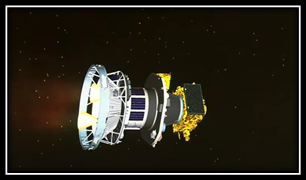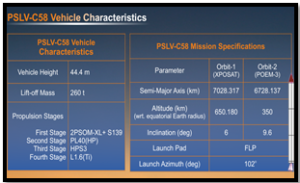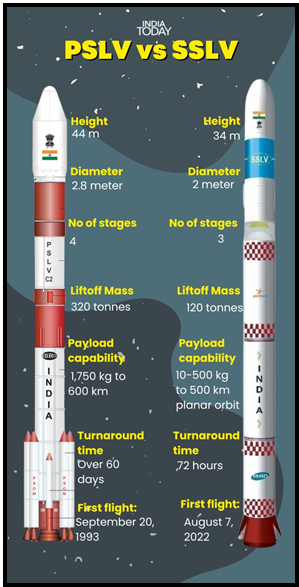A LIGHT IN SPACE
ISRO’s new observatory could help unravel some of the universe’s deepest secrets and mysteries
Relevance:
GS 3
- Science and Technology- developments
- Achievements of Indians in science & technology; indigenization of technology and developing new technology.
- Awareness in the fields of Space.
Why in News:
Recently, ISRO launched XpoSat, India’s first space observatory for cosmic X-ray polarization.
Source- Business Today
XPoSat (X-ray Polarimeter Satellite) is the first dedicated scientific satellite from ISRO to carry out research in space-based polarisation measurements of X-ray emission from celestial sources. The Satellite configuration is modified from the IMS-2 bus platform.
XpoSat Mission Launch
- On January 1st 2024, ISRO launched XpoSat, India’s first space observatory for cosmic X-ray polarization.
- Aims to uncover hidden aspects of the cosmos and revolutionize our understanding of the universe.
Polarimetric satellite
- A polarimetric satellite is a type of satellite equipped with instruments or sensors that are capable of measuring the polarization properties of electromagnetic waves, typically in the microwave or radar frequency range.
- Polarimetric satellites are used for various Earth observation and remote sensing applications, particularly in the field of meteorology, agriculture, and environmental monitoring.
The objectives of this mission are
- To measure polarisation of X-rays in the energy band 8-30keV emanating from about 50 potential cosmic sources through Thomson Scattering by POLIX payload.
- To carry out long term spectral and temporal studies of cosmic X-ray sources in the energy band 0.8-15keV by XSPECT payload.
- To carry out polarisation and spectroscopic measurements of X-ray emissions from cosmic sources by POLIX and XSPECT payloads respectively in the common energy band.
Scientific Goals of the Mission
- Investigate the structure and geometry of the magnetic field of neutron stars, explore the mechanisms behind X-ray beaming, and establish its relationship with the luminosity and mass accretion rate of powered pulsars.
- Attain a comprehensive understanding of galactic black hole binary sources.
- Examine and validate whether X-rays are produced either from the polar cap of a neutron star or the outer cap of a pulsar magnetosphere.
- Differentiate and confirm the dominance of the synchrotron mechanism over thermal emission in Supernova remnants.
XpoSat’s Payloads
- The Configuration of the mainframe systems are derived based on the heritage of IRS (Indian Remote Sensing) satellites.
- It carries two payloads namely
POLIX (Polarimeter Instrument in X-rays) POLIX is realized by Raman Research Institute
Source- ISRO
XSPECT (X-ray Spectroscopy and iming). XSPECT is by Space Astronomy Group of URSC
Source- ISRO
Launch vehicle used PSLV C 58
Source- ISRO
Source- India Today
Orbit Adjustment and Passivation Procedure for XPoSat:
- Initial Orbit: XPoSat is initially injected into a 650km orbit at a 6-degree inclination.
- Orbit Adjustment: The PS4 stage will undergo an orbit adjustment by performing two restarts, lowering it to a 350km orbit with an inclination of approximately 9.6 degrees.
- Propellant Disposal: To ensure the safety of the PS4 stage for future atmospheric re-entry experiments, the remaining propellant in the PS4 will be disposed of through the main engines. This disposal will follow a predetermined sequence, starting with the oxidizer and followed by the fuel. The existing method of passivating the spent stage by venting tank pressure will also be employed.
POEM
- Control Transition: After passivation, control of the PS4 stage will be transferred to the POEM Avionics system.
- PS4 stage is configured as a 3-axis stabilised orbital platform for conducting experiments to space qualify systems with novel ideas.
- Orbital Platform Configuration: The POEM PS4 stage serves as a 3-axis stabilized orbital platform for conducting experiments to space-qualify systems with innovative concepts.
- Power Supply: The PS4 stage’s electrical power needs are met by Flexible Solar Panels in conjunction with a 50Ah Li-Ion battery in a battery-tied configuration.
- Avionic Systems: The orbital platform includes avionic systems responsible for Navigation, Guidance, Control, and telecommands.
- Attitude Control: An Orbital Platform Attitude Control System is in place to manage the platform’s orientation for testing payloads.
X-ray Polarization
- Polarization of X-rays refers to the orientation of the electric field vector of X-ray photons as they propagate through space. Like other forms of electromagnetic radiation, X-rays consist of oscillating electric and magnetic fields.
- Strong magnetic fields in certain cosmic regions drive particles at high speeds, creating polarized light.
- Prior experiments on X-ray polarization were mainly balloon observations and short-duration experiments by NASA.
International Significance
- XpoSat is the world’s second mission to study the polarization of cosmic X-rays, following NASA’s IXPE launched in December 2021.
- Experts believe that combined observations from IXPE and XpoSat could answer long-standing astrophysical questions.
ISRO’s Expanding Horizons
- In 2023, ISRO transitioned into a planetary exploration agency with the launch of Chandrayaan-3 and Aditya-1.
- Upcoming collaboration with NASA for a mission to the International Space Station.
- Scheduled test flight of Gaganyaan without astronauts.
- ISRO demonstrates its expertise and maturity in all aspects of planetary research.
In conclusion, ISRO’s XpoSat observatory mission represents a significant milestone in India’s space exploration endeavors. By venturing into the uncharted realm of astrophysics, XpoSat aims to shed light on some of the universe’s deepest secrets, such as emissions from black holes and neutron stars.
Source
Indian Express
Mains Question
Q Discuss the significance of ISRO’s XpoSat observatory mission in the field of astrophysics and its potential contributions to unraveling cosmic mysteries. How does XpoSat’s mission align with ISRO’s evolving role in planetary exploration and its growing international collaboration efforts?

 Source- Business Today
Source- Business Today Source- ISRO
Source- ISRO Source- ISRO
Source- ISRO Source- ISRO
Source- ISRO Source- India Today
Source- India Today

